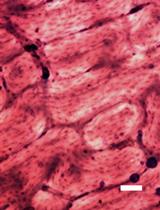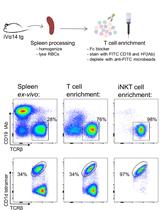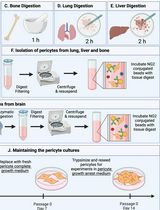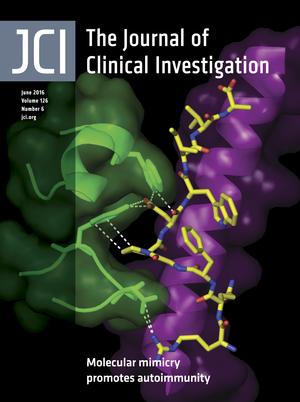- Submit a Protocol
- Receive Our Alerts
- Log in
- /
- Sign up
- My Bio Page
- Edit My Profile
- Change Password
- Log Out
- EN
- EN - English
- CN - 中文
- Protocols
- Articles and Issues
- For Authors
- About
- Become a Reviewer
- EN - English
- CN - 中文
- Home
- Protocols
- Articles and Issues
- For Authors
- About
- Become a Reviewer
Isolation of LYVE-1+ Endothelial Cells from Mouse Embryos
Published: Vol 8, Iss 15, Aug 5, 2018 DOI: 10.21769/BioProtoc.2962 Views: 5972
Reviewed by: Jia LiJijun ChengAnonymous reviewer(s)

Protocol Collections
Comprehensive collections of detailed, peer-reviewed protocols focusing on specific topics
Related protocols

A Rapid Protocol for Direct Isolation of Osteoclast Lineage Cells from Mouse Bone Marrow
Lei Dang [...] Jin Liu
Mar 5, 2022 4289 Views

Primary Mouse Invariant Natural Killer T (iNKT) Cell Purification and Transduction
Gloria Delfanti [...] Giulia Casorati
Jul 5, 2023 2118 Views

Isolation and Culture of Primary Pericytes from Mouse
Tamara McErlain [...] Meera Murgai
Apr 20, 2025 2888 Views
Abstract
Lymphatic vessel endothelial hyaluronan receptor 1, or LYVE-1, is a type 1 integral membrane glycoprotein expressed by lymphatic endothelial cells (LECs). LYVE-1 is commonly used as a biological marker to visually distinguish developing lymphatic vessels from blood endothelial cells (arteries or veins). As our understanding of lymphatic biology is still lacking today, the need to isolate LECs apart from other endothelial cells has taken on greater importance. The following procedure describes a magnetic bead separation procedure for isolating LEC-rich populations of cells from developing mouse embryos.
Keywords: LYVE-1Background
The lymphatic vasculature forms a secondary circulatory system that functions in draining extracellular fluid from tissue, allows for the transport of lipids, and provides immune cell trafficking and transport function. While our understanding of the lymphatic system has rapidly expanded in the last couple of decades, it is still lacking compared to our knowledge of arterial and venous biology. The identification of LYVE-1 receptor expression by LECs provided a useful tool to distinguish lymphatic tissue but LYVE-1 is known to be expressed in other tissues including liver and spleen sinusoidal cells and pancreatic exocrine and islet of Langerhans cells (Banerji et al., 1999). Encoded by the LYVE1 gene, the biological function of the LYVE-1 receptor has yet to be determined but it has been suggested to participate in tumor metastasis in addition to HA transport across endothelial cells (Jackson, 2003). Despite it being expressed in a variety of tissues, LYVE-1 is still a commonly used marker today to distinguish LECs from other endothelial cells. The goal of this procedure was to isolate LECs from developing mouse embryos with a positive selection approach using dynabeads conjugated to LYVE-1 antibody.
Materials and Reagents
- Pipettes tips (Eppendorf, catalog numbers: 022491105 , 022491113 , 022491121 , 022491164 )
- Microcentrifuge tube (Fisher Scientific, catalog number: 05-408-130 )
- 12-well cell culture plate (Greiner Bio One International, catalog number: 665102 )
- 40 μm strainer (Corning, Falcon® , catalog number: 352340 )
- Microcentrifuge tube magnet (New England Biolabs, catalog number: S1509S )
- Dynabeads: Sheep anti-rat IgG (Thermo Fisher Scientific, InvitrogenTM, catalog number: 11035 )
- LYVE-1 antibody, 0.5 mg/ml (R&D Systems, catalog number: AF2125 )
- Trizol solution (Thermo Fisher Scientific, InvitrogenTM, catalog number: 15596018 )
- RNA Prep Kit (QIAGEN, catalog number: 74106 )
- Bovine serum albumin (Rockland Immunochemicals, catalog number: BSA-50 )
- PBS w/o Ca2+ and Mg2+ (Merck, Omnipur®, catalog number: 6505-OP )
- Collagenase (Sigma-Aldrich, catalog number: 10103578001 )
- Dispase (Sigma-Aldrich, catalog number: D4693-1G )
- DNase (Thermo Fisher Scientific, AmbionTM, catalog number: AM2224 )
- HBSS (Thermo Fisher Scientific, GibcoTM, catalog number: 14175095 )
- Ammonium Chloride (NH4Cl) (Merck, Calbiochem, catalog number: 168320 )
- Sodium Bicarbonate (NaHCO3) (Merck, catalog number: SX0320-1 )
- Na2EDTA (EDTA disodium) (VWR, catalog number: 97061-022 )
- Molecular grade water (Sigma-Aldrich, catalog number: W4502-1L )
- PBS/BSA Solution (see Recipes)
- Enzyme Solution (see Recipes)
- RBC Lysis Buffer Solution (see Recipes)
Equipment
- Incubator (Fisher Scientific)
- Centrifuge (Eppendorf, model: 5415 R )
- NanoDropTM 2000 Spectrophotometers (Thermo Fisher Scientific, model: NanoDropTM 2000 )
Procedure
- Dynabead Preparation
- Pipette 500 μl of Dynabead solution (50 μl/embryo) into a microcentrifuge tube.
- Place on microcentrifuge tube magnet and remove the solution.
- Wash the Dynabeads with 1 ml PBS/0.1% BSA for 3 min on gentle rotation.
- Place the tube on microcentrifuge tube magnet and discard supernatant.
- Repeat Steps A3-A4 once.
- Add 1 ml PBS/0.1% BSA.
- Add 100 μg LYVE-1 mAb (10 μg of antibody/embryo) to the resuspended Dynabead solution.
- Incubate for 30-45 min at 4 °C with gentle rotation.
- Place the tube on magnet and discard supernatant.
- Resuspend Dynabeads by gently pipetting (100 μl/embryo) in 1 ml of PBS/BSA solution. Store at 4 °C until needed.
- Embryo Dissection and Endothelial Cell Isolation
- Euthanize pregnant mouse at E14.5; Remove uterus and isolate embryos.
- Expose the abdomen of the embryo and remove as much liver tissue as possible (see Notes).
- Cut embryo into 4-5 smaller pieces and digest tissue in 1 ml of enzyme solution for 30 min at 37 °C. Pipette mixture up and down several times every 10 min.
- Using a sterile 12-well cell culture plate and a 40 μm strainer, filter each mixture to remove debris; flush with 0.5-1 ml cold HBSS.
- Transfer each filtered solution to a separate microcentrifuge tube.
- Spin down cell solution at 600 x g for 1 min at 4 °C. Discard supernatant.
- Resuspend in 500 μl RBC lysis buffer, pipet up and down several times. Let rest on countertop for 5 min.
- Spin down cells at 600 x g for 1 min at 4 °C.
- Resuspend cells in 1 ml cold PBS/0.1% BSA.
- Add 100 μl prepared Dynabead-LYVE-1 solution (from Step A10) to each sample.
- Incubate for 45 min-1 h at 4 °C with gentle rotation.
- Place each tube on magnet for 5 min; discard supernatant.
- Wash pellet twice with 1 ml cold PBS/BSA by gentle pipetting up and down several times using a 1 ml pipette tip.
- Place each tube on magnet for 5 min; discard supernatant.
- Add 0.5 ml Trizol solution to each tube. Use immediately or freeze at -80 °C for later use.
- Isolate RNA using QIAGEN prep kit.
Data analysis
After isolating RNA using the isolation kit, RNA purity and quality should be checked prior to running any downstream experiments. For the purpose of this experiment, only samples with a 260/280 ratio of 1.9-2.1 were selected for RT-qPCR experiments. Purity was assessed using a Thermo Fisher Scientific Nanodrop 2000 device. However, standard spectrophotometers can also be used to assess quality.
Notes
The physiological role of the LYVE-1 receptor is still under debate, as well as exactly what tissues express the receptor at which time-point during mouse embryo development. LYVE-1 is highly expressed by sinusoidal liver cells (a specialized type of blood vessel) so removal of the liver prior to digesting the embryo would improve the purity of isolating lymphatic endothelial cells.
While this protocol describes a method for isolating cells and directly obtaining RNA for quantitative real-time PCR analysis, it can be adapted for a variety of downstream purposes. For example, after step 14 of Part B, cells could be eluted from the Dynabeads (according to manufacturer’s instructions), which would allow for alternative downstream methods to be employed (cell culture or fluorescence-activated cell sorting [FACS]) depending on the needs of the individual.
Recipes
- PBS/BSA Solution
Add 0.1% bovine serum albumin to PBS w/o Ca2+ and Mg2+ - Enzyme Solution
2.5 mg/ml collagenase
2.5 mg/ml dispase
25 μg/ml DNase
10 ml HBSS
3.RBC Lysis Buffer Solution150 mM NH4Cl (Ammonium Chloride) MW = 53.49 2 g 10 mM NaHCO3 (Sodium Bicarbinate) MW = 84.01 0.21 g 1 mM Na2EDTA (EDTA disodium) MW = 372.2 0.09 g Distilled H2O 250 ml
Acknowledgments
This procedure was developed in the laboratory of Dr. Courtney Griffin at the Oklahoma Medical Research Foundation in Oklahoma City, OK. There are no conflicts of interest.
References
- Banerji, S., Ni, J., Wang, S. X., Clasper, S., Su, J., Tammi, R., Jones, M. and Jackson, D. G. (1999). LYVE-1, a new homologue of the CD44 glycoprotein, is a lymph-specific receptor for hyaluronan. J Cell Biol 144(4): 789-801.
- Jackson, D. G. (2003). The lymphatics revisited: new perspectives from the hyaluronan receptor LYVE-1. Trends Cardiovasc Med 13(1): 1-7.
Article Information
Copyright
© 2018 The Authors; exclusive licensee Bio-protocol LLC.
How to cite
Crosswhite, P. (2018). Isolation of LYVE-1+ Endothelial Cells from Mouse Embryos. Bio-protocol 8(15): e2962. DOI: 10.21769/BioProtoc.2962.
Category
Developmental Biology > Cell growth and fate > Lymphangiogenesis
Cell Biology > Cell isolation and culture > Cell isolation > Dynabead
Do you have any questions about this protocol?
Post your question to gather feedback from the community. We will also invite the authors of this article to respond.
Share
Bluesky
X
Copy link








